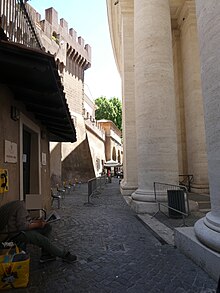Ricciolo d'Italia
41°54′13″N 12°27′23″E / 41.90361°N 12.45639°E

Ricciolo d'Italia (lit. 'the Curl of Italy') is a narrow section of the border between Vatican City and Italy with a characteristic curl shape with a maximum width of only 3 meters. It came into existence on February 11, 1929, with the signing of the Lateran Pacts,[1][2] which came into force the following June 7 following the simultaneous publication of the ratifications in the Official Gazette of the Kingdom of Italy and the Acta Apostolicae Sedis.
Description

The Ricciolo d'Italia originates near the Porta Angelica on the boundary that follows the Leonine Wall to just before the Bernini colonnade in St. Peter's Square, where a small part of Italian territory creeps into Vatican territory, separating it into two parts, just behind the right arm of the colonnade itself.[3] The exact line is marked on the ground by a curved travertine line. The dimensions are 3 meters in width, with a length of about 70 meters, in a semicircular shape. The extreme tip is near the Apostolic Palace.
This strip of Italian soil is mistakenly considered, both because of the incongruity of the situation and for practical reasons, to be part of Vatican territory. Even the Italian police forces and the Swiss guards stationed there consider that strip to belong to the Vatican. The curl is freely accessible only in the initial, non-transitioned part.[2]
The curl of Italy is overlooked, from east to west, by several buildings and/or constructions whose view is limited by their extreme proximity to the colonnade of St. Peter's: the Church of Saints Martin and Sebastian of the Swiss, the Porta San Pellegrino, the Vatican post office and the Apostolic Palace.[4][5]
History
Article 3 of the Lateran Pacts states generically that "The boundaries of said [Vatican] City are indicated on the Plan which constitutes Annex I° of the present Treaty, of which it forms an integral part." The same article also states that when the Holy See intends to hold particular functions in St. Peter's Square, the Italian authorities must withdraw beyond the outer lines of the Bernini colonnade and its extension. Article 15 of the treaty confirms that extraterritoriality does not extend to the areas adjacent to the colonnade.[6]
The 1:5000 scale map attached to the Lateran Pacts, signed by Benito Mussolini and Cardinal Pietro Gasparri, is not particularly detailed and in some places there are small differences between the cartography published in the Official Gazette[7] and the Acta Apostolicae Sedis.[8]
For this reason, lacking a precise description of the borders, a bilateral Italian-Vatican commission was formed to verify precisely the boundaries between the two states; however, after three years of work, the conclusions reached in 1932 were no longer ratified. Since this commission had only an advisory purpose, the Italian government did not recognize any legal significance to this dispute. However, in some cases customs have since been consolidated over time.[9]
In the past, the Metropolitan City of Rome Capital considered the area as belonging to the Vatican, thus failing to issue a license to the wayside shrine located next to the Porta Angelica.[10] The curl, however, appears to be included in the georeferenced map of municipal boundaries, but not in the cadastral map.[11]
References
Citation notes
- ^ Vito La Colla. "10 cose curiose e poco note sulla Città del Vaticano". Corriere della sera. Retrieved 24 May 2020.
- ^ a b "articolo sul confine italo-vaticano e le sue peculiarità". inftub.com. Retrieved 24 May 2020.
- ^ Aldo Maria Valli. Piccolo mondo vaticano. Roma: Gius.Laterza & Figli Spa. Retrieved 24 May 2020.
- ^ "Mappa del Vaticano". 24timezones. Retrieved 24 May 2020.
- ^ "Mappa e cartina dei monumenti città del vaticano". mapparoma360. Retrieved 2020-05-24.
- ^ "Inter Sanctam Sedem et Italiae Regnum Conventiones". 1929-11-02.
- ^ "Legge 24 giugno 1929, n. 810, "Esecuzione del Trattato, dei quattro allegati annessi e del Concordato, sottoscritti in Roma, fra la Santa Sede e l'Italia, l'11 febbraio 1929 - VII"". Gazzetta Ufficiale del Regno d'Italia (130 bis): 6. 1929-06-05.
- ^ Eugenio Bonanata; Giovanni Orsenigo (2019-02-11). "Patti Lateranensi: l'entrata in vigore degli accordi". Vatican News.
- ^ Aldo Maria Valli (2013). Piccolo mondo vaticano. Roma-Bari: Gius.Laterza & Figli Spa. pp. 29–30.
- ^ Cesare Maffi (2019-07-13). "I confini confusi del Vaticano". Italia Oggi. No. 164. p. 10.
- ^ "Cartografia". Geo Portale del Comune di Roma. Retrieved 2020-05-27.


